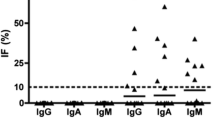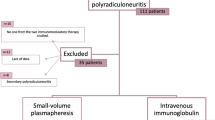Summary
In recent years, plasmapheresis has become a well established treatment of acute and chronic polyradiculoneuritis (Guillain-Barré syndrome, GBS). Nervertheless, there are still non-responders and there are particular risks associated with this treatment. Despite all efforts, the duration of severe forms of Guillain-Barré syndrome is still considerable. Inflammation and demyelination start intrathecally. We therefore used liquorpheresis (cerebrospinal fluid filtration) as a new effective therapeutic approach. Our first patient, severely disabled with acute GBS, artificially ventilated, had undergone plasma exchange without effect. Plasma immunoadsorption led only to transient improvement. After several liquorphereses, the patient recovered completely. In three additional patients with acute and two with chronic GBS an improvement of clinical signs in close temporal relation to liquorpheresis was observed. Twice, liquorpheresis was combined with immunoadsorption of cerebrospinal fluid. Liquorpheresis was well tolerated in all cases. This procedure may be effective by eliminating humoral or cell-bound factors responsible for the onset or/and maintenance of inflammation. Further controlled studies are necessary and are in progress.
Similar content being viewed by others
References
Besser R, Pfeifer B, Weilemann LS, Hopf HC (1986) Plasmapherese beim Guillain-Barré Syndrom. Med Klin 12:409–413
Brettle RP, Gross M, Legg NJ, Lockwood M, Pallis C (1978) Treatment of acute polyneuropathy by plasma exchange. Lancet II:1100
Brinkmeier H, Wollinsky KH, Rüdel R, Hülser P-J: unpublished data
Dyck PJ, Daube J, O'Brien P, Pineda A, Low PA, Windebank AJ, Swanson C (1986) Plasma exchange in chronic inflammatory demyelinating polyradiculoneuropathy. N Engl J Med 314:461–465
Ferner R, Barnett M, Hughes RAC (1987) Management of Guillain-Barré syndrome. Br J Hosp Med 12:525–530
Gross MLP, Thomas PK (1981) The treatment of chronic relapsing and chronic progressive idiopathic inflammatory polyneuropathy by plasma exchange. J Neurol Sci 52:69–78
Gruener G, Bosch EP, Strauss RG, Klugman M, Kimura J (1987) Prediction of early beneficial exchange in Guillain-Barré syndrome. Arch Neurol 44:295–298
Guillain-Barré syndrome Study Group (1985) Plasmapheresis and acute Guillain-Barré syndrome. Neurology 35:1096–1104
Hartung H-P, Schwenke CH, Bitter-Suermann D, Toyka K (1987) Guillain-Barré syndrome: activated complement components C3a and C5a in CSF. Neurology 37:1006–1009
Hughes RAC (1989) Immunotherapy in neurology. Curr Opin Neurol Neurosurg 2:186–190
Levy RL, Newkirk R, Ochoa J (1979) Treatment of chronic relapsing Guillain-Barré syndrome by plasma exchange. Lancet II:259–260
Nathan CF (1987) Secretory products of macrophages. J Clin Invest 79:319–326
Ostermann PO, Fagius J, Säfwenberg J, Danersund A, Wallin BG, Nordesjö LO (1982) Treatment of the Guillain-Barré syndrome by plasmapheresis. Arch Neurol 39:148–154
Pollard JD (1987) A critical review of therapies in acute and chronic inflammatory demyelinating polyneuropathies. Nuscle Nerve 10:214–221
Sanders ME, Koski CL, Robbins D, Shin ML, Fank MM, Joiner KA (1986) Activated terminal complement in cerebrospinal fluid in Guillain-Barré syndrome and multiple sclerosis. J Immunol 136:4456–4459
Server AC, Lefkowith J, Braine H, McKhan GM (1979) Treatment of chronic relapsing inflammatory polyradiculoneuropathy by plasma exchange. Ann Neurol 6:258–261
Wiethölter H (1989) Verlaufsformen der experimentell- allergischen Neuritis. Elektrophysiologische Untersuchungen und Behandlung durch Plasmaseparation. In: Bauer HJ, Baumgartner G, Davison AN, Gänshirt H, (Eds) Schriftenreihe Neurologie, part 31, Springer, Berlin Heidelberg New York Paris Tokyo
Wiethölter H, Hülser P-J, Linington C, Meier CH, Wessel K (1988) Electrophysiological follow-up of experimental allergic neuritis, mediated by permanent T-cell line in rats. J Neurol Sci 83:1–14
Wollinsky KH, Mehrkens H-H, Hülser P-J, Weindler M, Geiger P, Matzek N, Kornhuber HH (1989) Liquorpherese, Liquorfiltration als neues Therapieverfahren bei der Behandlung eines schweren Guillain-Barré Syndroms. Anaesthesist 38 Supplement 1:630
Author information
Authors and Affiliations
Rights and permissions
About this article
Cite this article
Wollinsky, K.H., Weindler, M., Hülser, P.J. et al. Liquorpheresis (CSF-filtration): An effective treatment in acute and chronic severe autoimmune polyradiculoneuritis (Guillain-Barré syndrome). Eur Arch Psychiatry Clin Nuerosci 241, 73–76 (1991). https://doi.org/10.1007/BF02191143
Received:
Issue Date:
DOI: https://doi.org/10.1007/BF02191143




